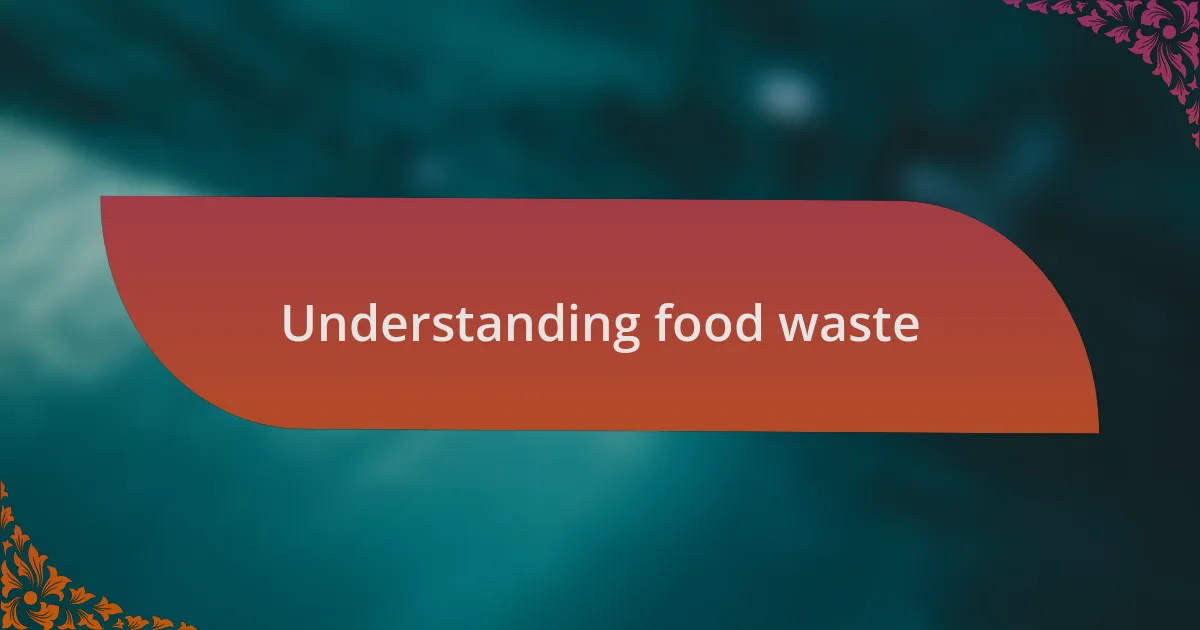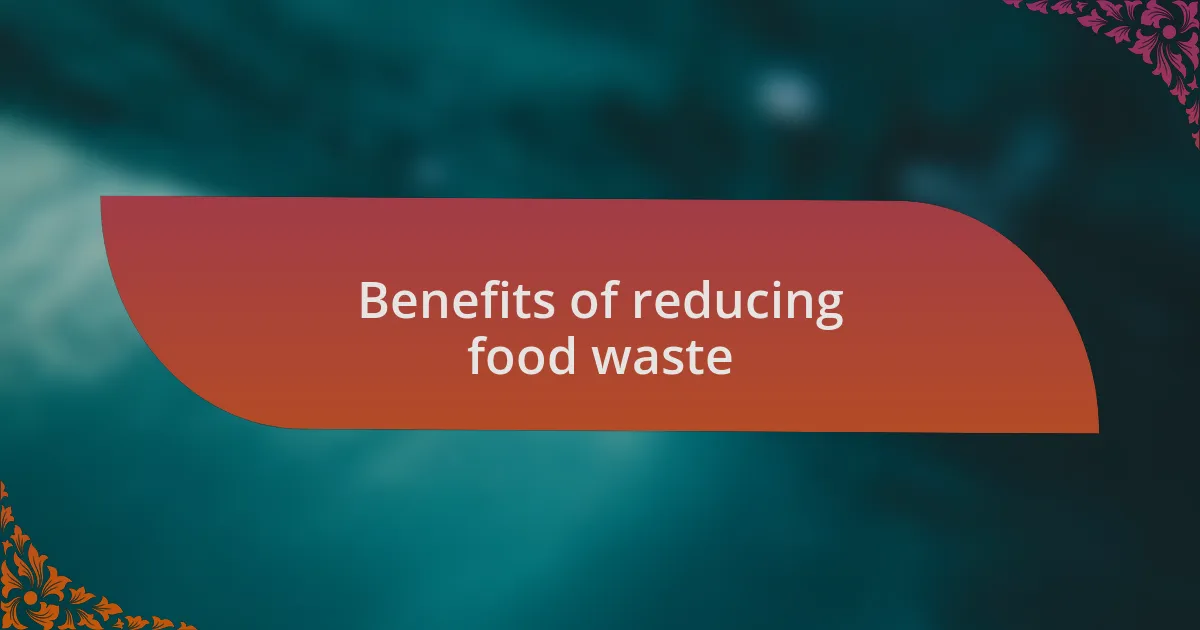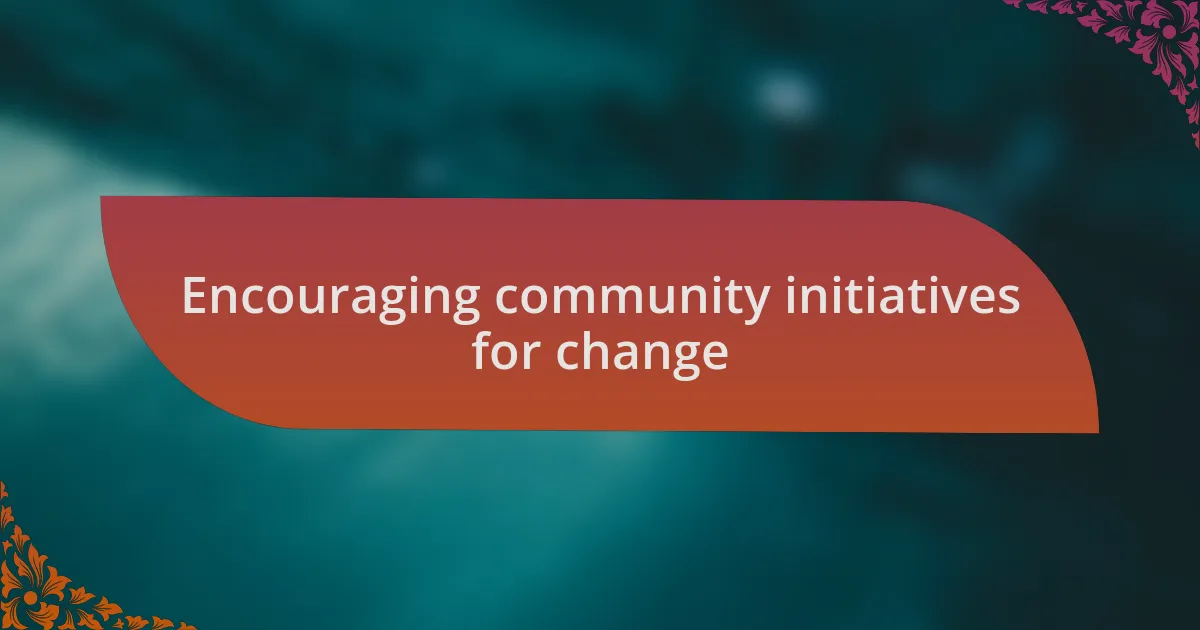Key takeaways:
- Approximately one-third of globally produced food is wasted, impacting the environment and highlighting the need for mindful consumption.
- Reducing food waste not only lowers carbon footprints but also saves money and fosters community connections through sharing and collaboration.
- Practical strategies such as meal planning, understanding food labels, and freezing leftovers can significantly minimize waste.
- Engaging in community initiatives like potlucks and food recovery drives encourages collective action towards reducing food waste.

Understanding food waste
Food waste is often larger than we imagine, and it’s alarming to realize that around one-third of all food produced globally is never consumed. Reflecting on my culinary experiences, I remember a time when my family would regularly buy more vegetables than we could use, leading to soggy leftovers destined for the trash. Have you ever opened your fridge, only to find something old and unrecognizable at the back? It’s a common scenario, and it made me question how we can be more mindful about our consumption habits.
Understanding food waste goes beyond just leftover meals; it encompasses the entire supply chain, from farm to table. Every bite that goes uneaten contributes to greenhouse gas emissions and strains ocean ecosystems, which is something that truly saddens me. One summer, I volunteered at a local food bank and witnessed how perfect fruits and vegetables were often discarded simply because they didn’t meet aesthetic standards. It made me wonder, who decided that only the ‘pretty’ produce deserves a chance?
I have learned that sacrificing a bit of convenience can lead to impactful change. For example, I started planning my meals more carefully to avoid over-purchasing. It’s a small effort, but each time I’m able to turn our food scraps into compost or donate extras to my community, I feel a connection to both my kitchen and the larger environmental impact. Isn’t it uplifting to think how our choices can ripple outward, influencing the health of our oceans and planet?

Benefits of reducing food waste
Reducing food waste brings immediate environmental benefits that I’ve come to appreciate over time. When I started being more mindful of my purchasing habits, I realized that the less food I wasted, the smaller my carbon footprint became. It’s astonishing to think that wasted food emits methane in landfills—a potent greenhouse gas. Knowing that my choices can help mitigate climate change is something that motivates me profoundly.
Another unexpected advantage I’ve noticed relates to the financial aspect of reducing food waste. I remember when my grocery bills were noticeably higher, largely due to impulsive buying. Now, by planning meals and using what I have on hand, I’m saving money that I can allocate to other environmentally friendly practices, like buying local produce. Isn’t it gratifying how being intentional in one area can yield benefits in another?
Moreover, I’ve discovered that reducing food waste nurtures a sense of community. One memorable experience was when I joined a local group that exchanges surplus food. It was so fulfilling to see how sharing what I couldn’t use filled others’ plates and minimized waste at the same time. How often do we think about the joy of connecting with others over food? By sharing our excess, we not only help the environment but also strengthen our bonds, making it feel like a collective journey toward sustainability.

Strategies to decrease food waste
One effective strategy I’ve adopted is to create a detailed shopping list before hitting the grocery store. It’s funny how that simple act transforms my experience—I no longer find myself drawn to shiny packaging or impulse buys in the cereal aisle. Instead, I focus solely on what I need, which not only saves me money but directly reduces the chances of food going to waste at home. Have you experienced that moment of regret when something perishes in the fridge? I certainly have, and it’s something I wanted to avoid.
Another approach that has served me well is batch cooking and meal prepping. On Sundays, I set aside a few hours to prepare meals for the week. The reward is twofold: I have delicious homemade meals ready to go, and it minimizes the risk of me scraping leftovers into the trash. There’s something quite satisfying about organizing my week in this way. How much easier do you think it would be to eat right when everything is prepped?
Lastly, I’ve learned the importance of getting creative with leftovers. For example, one night I had roasted vegetables that were nearing their end. With a little imagination and a few spices, I turned them into a vibrant soup. It’s amazing how a little creativity can stretch those ingredients further while adding something new to my culinary repertoire. I encourage you to think about how you can reimagine your leftovers; you might be surprised at what you can create!

Personal journey in reducing waste
I vividly remember my first big attempt to reduce waste during a memorable family holiday meal. We prepared a feast that could have fed an army, and as we sat down to eat, I felt the stress of potential leftovers looming over me. That evening, instead of stashing away excess food that would likely go uneaten, we got creative and turned it into a potluck-style picnic the next day. Not only did we savor every bite, but we strengthened our bonds over a shared meal. Have you ever turned a daunting excess into a joyful gathering?
Another impactful moment in my journey was learning to store food properly. Initially, I neglected the importance of packaging, resulting in sad, wilted produce and expired pantry items. One day, after discovering a bag of spoiled spinach that I had intended to use in a smoothie, I felt a wave of frustration wash over me. That prompted me to research storage methods—now I use transparent containers and label items with dates. It has significantly reduced spoilage. How often do we overlook the small solutions that can lead to substantial changes?
Recently, I also started participating in a local community exchange for surplus food. It’s heartwarming to witness how neighbors collaborate and share their extra produce and homemade goods. Engaging in this initiative made me appreciate our collective effort to minimize waste. Have you considered how community connections can amplify individual actions in the quest to reduce food waste? It truly demonstrates how one person’s surplus can be another person’s delight.

Practical tips for everyday reductions
One of the easiest ways I’ve found to reduce food waste is by planning meals ahead of time. Each week, I take a moment to jot down a simple menu based on what I already have in my fridge and pantry. This not only helps me buy only what’s necessary, but I’ve also discovered the joy in getting creative with ingredients I might otherwise forget about. Have you ever turned that slightly overripe banana into a delicious smoothie?
Another practical tip I swear by is understanding expiration dates on food labels. While some items can be safely consumed beyond their sell-by dates, others may require more scrutiny. For instance, I once assumed a jar of pasta sauce was past its prime, only to find it still perfectly fine. This experience taught me to trust my senses—smell, taste, and visual inspection—and not solely rely on dates. Isn’t it fascinating how many assumptions we make about food freshness?
Lastly, I’ve embraced the art of freezing leftovers. I remember the first time I carefully packed away a homemade vegetable stew; it was like unearthing a treasure when I rediscovered it months later. Freezing not only extends the life of meals but allows me to enjoy the flavors of my cooking at a later date, without the guilt of waste. Have you ever opened your freezer to find a precious reminder of a cozy night in? It’s a simple, yet effective way to ensure that every bite matters.

Encouraging community initiatives for change
Engaging communities in initiatives to combat food waste has been one of the most rewarding aspects of my journey. I remember organizing a neighborhood potluck where everyone brought a dish made from leftover ingredients. It was a vibrant display of creativity, and seeing the joy on everyone’s faces as they shared their culinary creations reinforced the idea that we can all contribute to reducing waste while building connections. Isn’t it wonderful how a simple gathering can inspire sustainable habits?
In my experience, local clean-up events paired with food recovery drives can also galvanize participation. When I volunteered at a beach cleanup, we not only collected trash but also set up a booth to educate attendees on foraging edible foods while minimizing waste. It was eye-opening to see how many people hadn’t realized that some discarded items could still be useful. I found it fascinating to witness the spark of interest in others as they learned about these options.
I’ve also noticed that partnering with local businesses can amplify our efforts. For instance, a local café I frequent started donating leftover baked goods to a nearby shelter after I suggested it during a chat. This small change created a ripple effect, encouraging other businesses to consider similar approaches. Have you ever thought about how collective efforts in your community could lead to meaningful change? It’s inspiring to see that every action, no matter how small, can significantly impact food waste reduction.